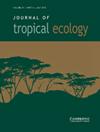克服热带干旱林的更新障碍:水分胁迫和草食对幼苗性能和关键树种恢复分配的影响
IF 1
4区 环境科学与生态学
Q4 ECOLOGY
引用次数: 1
摘要
热带干林(TDF)是美洲最受威胁和保护最差的生态系统之一。尽管国际上对TDF的恢复做出了努力,但由于降水变化导致的草食或水分限制等应激因素如何影响这些森林的更新动态却知之甚少。具体来说,TDF恢复的关键树种幼苗如何应对当前的非生物压力,如气候事件的加剧,以及草食等生物因素,目前还没有完全了解。在为期8个月的温室试验中,我们比较了3种豆科植物和1种非豆科植物TDF树种的幼苗性能、生物量分配和根系与梢间水分分配情况,作为对水分限制和草食的响应。与我们的预期相反,我们发现非豆科植物ulmifolia比豆科植物表现最好,而固氮和不固氮的豆科植物表现相似。基于我们的研究结果,我们建议在TDF修复项目中使用杜鹃花,因为它在非生物和生物胁迫因素下具有较高的性能,并且它可以将生物量和水分分配给地下结构。我们还建议使用固氮豆科植物,因为它们具有固定氮的能力,这保证了土壤的氮输入,这在演替的第一阶段很重要。然而,本实验中使用的豆科植物似乎没有抵抗所研究的非生物和生物应激源。因此,研究干旱森林植物物种对胁迫因子的响应是提供和确保更有效的TDF恢复工作的关键。本文章由计算机程序翻译,如有差异,请以英文原文为准。
Overcoming the regeneration barriers of tropical dry forest: effects of water stress and herbivory on seedling performance and allocation of key tree species for restoration
Tropical dry forests (TDF) are one of the most threatened and poorly protected ecosystems in the Americas. Although there are international efforts for the restoration of TDF, how stress factors such as herbivory or water limitation due to changes in precipitation, impact the regeneration dynamics of these forests is poorly understood. Specifically, how seedlings of key tree species for TDF restoration cope with current abiotic pressures such as the intensification of climatic events, and biotic factors like herbivory, is not yet fully understood. Here, we compared seedling performance, and allocation of biomass, and water to roots vs. shoots for three legume, and one non-legume TDF tree species, as a response to water limitation and herbivory in an 8-month greenhouse experiment. Contrary to our expectations, we found that the non-legume species, G. ulmifolia, had the best performance compared to legumes, while N-fixing and non-fixing legumes showed similar performance. Based on our findings, we suggest the use of G. ulmifolia in TDF restoration projects due to its high performance despite abiotic and biotic stress factors, its allocation of biomass and water to belowground structures. We also recommend the use of N-fixing legume species owing to their ability to fix nitrogen, which guarantees an N input to the soil, important in the first stages of succession. However, the legume species used in this experiment do not appear to resist the abiotic and biotic stressors studied. Thus, more studies exploring the response of dry forest plant species to stress factors are key for informing and assuring more effective TDF restoration efforts.
求助全文
通过发布文献求助,成功后即可免费获取论文全文。
去求助
来源期刊

Journal of Tropical Ecology
环境科学-生态学
CiteScore
2.10
自引率
0.00%
发文量
44
审稿时长
18-36 weeks
期刊介绍:
Journal of Tropical Ecology aims to address topics of general relevance and significance to tropical ecology. This includes sub-disciplines of ecology, such as conservation biology, evolutionary ecology, marine ecology, microbial ecology, molecular ecology, quantitative ecology, etc. Studies in the field of tropical medicine, specifically where it involves ecological surroundings (e.g., zoonotic or vector-borne disease ecology), are also suitable. We also welcome methods papers, provided that the techniques are well-described and are of broad general utility.
Please keep in mind that studies focused on specific geographic regions or on particular taxa will be better suited to more specialist journals. In order to help the editors make their decision, in your cover letter please address the specific hypothesis your study addresses, and how the results will interest the broad field of tropical ecology. While we will consider purely descriptive studies of outstanding general interest, the case for them should be made in the cover letter.
 求助内容:
求助内容: 应助结果提醒方式:
应助结果提醒方式:


